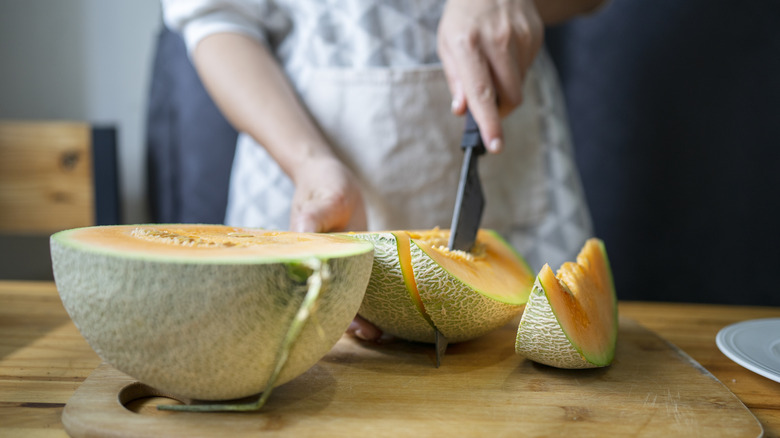The Popular Melon You Should Avoid Eating At A Continental Breakfast Buffet
If you've ever stayed at a hotel, you've probably encountered the classic continental breakfast spread. It's a quick and convenient way to fuel up before a day of meetings or sightseeing. You'll often see coffee, tea, yogurt, pastries, and maybe some cold cereals available to make it easy to eat and run. To get in some of your daily fiber, you may be inclined to grab some of the offerings of fruit, perfectly sliced and ready to eat.
While cantaloupe can be a refreshing pick in the summer months, pre-cut cantaloupe might not be the safest choice on a buffet line. At home, you can take steps to prepare cantaloupe safely. But once cantaloupe is cut and left sitting out — like on a buffet table — there's a higher risk it could become contaminated with harmful bacteria like listeria or salmonella. These bacteria thrive at room temperature, making buffet setups a potential food poisoning hazard.
You might recall the salmonella outbreak in November 2023 that spread across 44 states and sickened over 400 people. The Centers for Disease Control and Prevention reported that 158 people were hospitalized and six people died. An investigation by the Food and Drug Administration traced the salmonella outbreak to cantaloupe.
Why cantaloupe is more susceptible to bacteria
Buffets can be easy breeding grounds for bacteria and viruses due to the problem of keeping foods at a safe temperature. According to the USDA, hot foods should be kept above 140 degrees Fahrenheit, and cold foods should be kept below 40 degrees Fahrenheit. Foods shouldn't stay at room temperature for longer than two hours.
Cantaloupe poses a particular challenge for controlling bacteria. Those ridges on the skin of a cantaloupe can trap bacteria from when the fruit is growing to the time it is prepared for the buffet. Although you don't eat the skin of the cantaloupe, the bacteria can contaminate the knife and spread to the edible flesh of the fruit. If cantaloupe is kept at room temperature, the high water content, neutral pH, and sugar in cantaloupe's flesh make it particularly vulnerable to bacteria like salmonella (here's what really happens to your body when you get salmonella).
A 2025 article in the Journal of Food Protection analyzed melon-associated salmonella outbreaks worldwide in the past 30 years and found that cantaloupes were responsible for 43% of the outbreaks and 73% of the deaths. Pre-cut cantaloupe and public settings (such as buffets) were responsible for some of the larger salmonella outbreaks.
How to eat cantaloupe safely
Cantaloupe is rich in vitamin C and beta carotene, and its 90% water content will keep you hydrated (here are some health benefits of cantaloupe). Food safety experts at Northeastern University suggest avoiding buying pre-cut cantaloupe because you don't know how long ago the cantaloupe was cut. Bacteria can grow quickly as the cut cantaloupe is packaged and stored in the produce section.
When choosing cantaloupe at the store, be sure there aren't any cuts in the rind. Bacteria can enter through these cuts and contaminate the flesh of your cantaloupe. Although it's difficult to completely sanitize the outside of the cantaloupe before you cut into it, State Food Safety suggests scrubbing the outside of the cantaloupe with antibacterial soap. Be sure to wash your hands, utensils, and any surfaces before slicing open the cantaloupe and after you've handled the fruit. The Government of Canada says you can store cut cantaloupe and other melons in your refrigerator for up to four days, but toss out the fruit if it's been sitting out for more than two hours. If it's warm outside and you're serving fresh-cut melon, you may need to throw out the fruit sooner.


